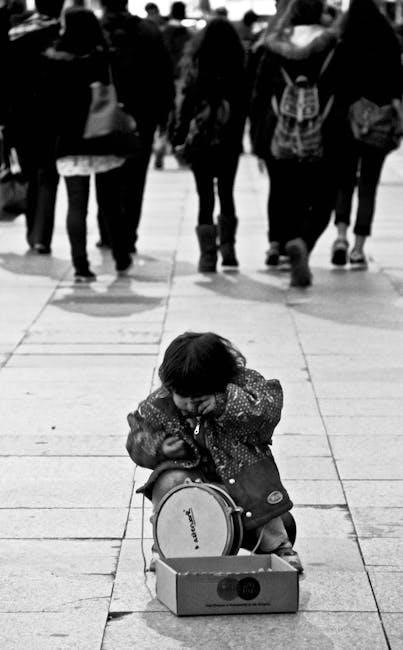Music, as an art form, is composed of seven key elements: melody, harmony, rhythm, dynamics, tone color, texture, and form. These elements combine to create meaningful musical experiences, guiding emotional expression and structural complexity in compositions.
Overview of the 7 Elements of Music
The seven elements of music—melody, harmony, rhythm, dynamics, timbre, texture, and form—serve as the foundation for creating and understanding musical compositions. Melody refers to the sequence of pitches heard in a piece, while harmony involves the combination of multiple pitches sounding simultaneously. Rhythm pertains to the patterns of duration and accentuation of sounds. Dynamics describe the loudness or softness of music, and timbre is the unique tone quality of instruments or voices. Texture is the layering of melodic lines, and form is the overall structure of a piece. Together, these elements create the rich diversity of musical expression and emotional impact.
Why Understanding Music Elements is Important
Understanding the elements of music—melody, harmony, rhythm, dynamics, timbre, texture, and form—is crucial for both musicians and non-musicians. For musicians, this knowledge enhances creativity and technical skill, enabling better composition and performance. It provides tools to express emotions effectively and structure musical ideas coherently. For everyone, it deepens appreciation by revealing how elements like melody and harmony contribute to a piece’s emotional impact. This understanding also aids in music education, making complex concepts accessible. It offers cultural insights, as different musical traditions highlight unique elements. In therapy, manipulating elements like rhythm can create therapeutic experiences. Composers rely on these elements to craft meaningful works, while producers use them to maximize digital tools’ potential. Music critics use them to analyze works, and marketers leverage elements like catchy melodies in advertising. Historically, these elements have evolved, reflecting societal changes. Ultimately, grasping music elements fosters creativity, enhances enjoyment, and enriches engagement with music on multiple levels.
Melody
Melody is the succession of pitches heard in a musical line, creating a sense of contour and emotional expression through rising and falling intervals.
Pitch and Its Role in Melody
Pitch is the perceived highness or lowness of a sound and is fundamental to melody. It creates the horizontal structure of music, distinguishing one note from another. In melodies, pitch variations define the contour, which can be rising, falling, or wavering. This variation engages listeners emotionally and intellectually. Pitch is notated on the staff, with higher pitches on upper lines and lower pitches on lower lines. The arrangement of pitches in a melody gives it uniqueness and character, making it a core element of musical expression.
Intervals and Motifs in Melodic Structure
Intervals, the spaces between pitches, are the building blocks of melody. They determine the melody’s contour and emotional impact. A motif is a short, memorable melodic idea that can be repeated, varied, or developed. Motifs often serve as the foundation for thematic material, providing unity and coherence. Intervals and motifs work together to create melodic lines that are both structured and expressive, allowing composers to craft melodies that resonate with listeners and convey specific moods or narratives.
Harmony
Harmony involves the combination of multiple pitches sounding simultaneously, creating chords and chord progressions. It adds depth, complexity, and emotional richness to musical compositions.
Chord Progressions and Their Function
Chord progressions are sequences of chords that create harmonic movement within a piece. They establish tonality, guide emotional expression, and provide structural foundation. Common progressions, like the diatonic series, follow the key’s scale, while chromatic progressions introduce tension. Chords function to resolve or create harmonic interest, often leading the listener’s ear to a satisfying conclusion. In composition, chord progressions are essential for establishing mood and narrative, making them a fundamental tool for musicians and composers across all genres.

Modulation and Key Changes in Harmony
Modulation refers to the process of changing the tonal center in a musical piece, often enhancing emotional depth and structural development. Key changes are achieved through specific techniques, such as pivot chords or common tones, which smoothly transition between keys. This harmonic shift can create contrast, surprise, or resolution, adding variety to compositions. Modulation is essential in complex works, allowing composers to explore new musical territories while maintaining coherence. It is a powerful tool for expressing narrative or emotional progression, making it a cornerstone of harmonic innovation in music.

Rhythm
Rhythm involves patterns of duration, accentuation, and rest, creating a sense of pulse and meter. Tempo, time signatures, and articulation shape rhythmic expression, adding complexity and emotion to music.
Tempo and Its Impact on Musical Feel
Tempo, the speed at which music is played, significantly influences the overall feel of a composition. Faster tempos can create energy and urgency, while slower tempos evoke reflection or grandeur. Tempo markings, such as allegro (fast) and adagio (slow), guide performers. Changes in tempo, like accelerando or ritardando, add dynamic contrast. Tempo also affects the perceived mood and emotional impact of a piece, making it a crucial element in shaping the listener’s experience. Understanding tempo is essential for both performers and composers to convey intended emotions effectively.
Meter and Time Signatures in Rhythmic Structure
Meter refers to the repetitive pattern of strong and weak beats, creating a rhythmic framework. Time signatures, such as 4/4 or 3/4, indicate the number of beats per measure and the type of note receiving the beat. Common time (4/4) is widespread, while waltz time (3/4) suggests a triple meter. Meter and time signatures organize rhythm, providing structure for composers and performers. They influence how music is interpreted, ensuring consistency in rhythmic execution and enhancing the overall musical feel. Understanding meter and time signatures is vital for accurate performance and composition.
Articulation and Its Effects on Rhythmic Clarity
Articulation refers to how notes are attacked and played, influencing rhythmic clarity. Techniques like legato (smooth connections) and staccato (short, detached notes) shape the feel of a piece. Legato creates a flowing sound, while staccato adds precision and separation. Proper articulation ensures rhythmic accuracy, as it defines the start and end of notes. In complex rhythms, clear articulation helps musicians and listeners distinguish between notes. Dynamics and tempo also interact with articulation, enhancing or altering rhythmic perception. Effective articulation is essential for maintaining clarity and expression in musical performance, making it a critical element of rhythmic structure and interpretation.

Dynamics
Dynamics refer to variations in loudness and softness in music, creating contrast and emotional depth. They guide musicians on how to express the intensity of a piece.
Loudness and Softness in Musical Expression
Loudness and softness in music, known as dynamics, are essential for expressing emotion and intensity. Musicians use terms like fortissimo (ff) for very loud and pianissimo (pp) for very soft. These markings guide performers on intensity levels, creating contrast and depth in a piece. Sudden shifts in dynamics can highlight dramatic moments, while gradual changes build tension or resolution. Dynamics not only enhance the technical execution of music but also shape its emotional narrative, connecting listeners to the composer’s intent and the performer’s interpretation. This element ensures music remains engaging and impactful, avoiding monotony in expression.
Contrast and Gradation in Dynamic Markings
Dynamic contrast refers to the juxtaposition of loud and soft passages, creating dramatic effects and emotional depth in music. Gradation involves gradual shifts in volume, such as crescendo (getting louder) or decrescendo (getting softer). These techniques add layers of tension and release, guiding the listener’s emotional journey. Composers often use dynamic markings like ff (very loud) to pp (very soft) to emphasize contrasts, while phrases like cres. or decres. signal gradual changes. Together, contrast and gradation enhance the expressive potential of music, making it more engaging and structurally rich. They are fundamental tools for shaping the narrative of a composition.

Timbre
Timbre, or tone color, distinguishes one voice or instrument from another, even when playing the same note. It creates unique sonic identities, from a piano’s brightness to a violin’s warmth, adding richness and variety to music.
Tone Color and Instrumental Characteristics
Tone color, or timbre, is the unique quality that distinguishes one instrument or voice from another. It is shaped by factors such as the material of the instrument, its shape, and the way sound is produced. For example, the bright, piercing sound of a trumpet contrasts with the mellow, resonant tone of a cello. This distinctiveness allows instruments to be easily identified, enriching the overall texture of a musical composition. Understanding tone color helps musicians and composers create vivid, expressive soundscapes that engage listeners on a deeper level.
Vocal vs. Instrumental Timbre
Vocal and instrumental timbre differ in their production and emotional impact. Vocal timbre is shaped by the human voice, with unique qualities like warmth, breathiness, or vibrato, often conveying emotion directly. Instrumental timbre varies widely, from the bright clarity of a flute to the rich depth of a cello. While both can express emotion, vocal timbre often carries linguistic meaning, whereas instrumental timbre relies on sound quality alone. This distinction allows composers to create contrast and depth in music, blending the expressive capabilities of both voices and instruments to craft compelling musical narratives and evoke powerful emotions in listeners.
Texture
Texture refers to the layering of sounds in music, involving monophony, homophony, and polyphony. It defines how melodic lines interact, creating complexity and depth in compositions.
Monophony, Homophony, and Polyphony
Monophony features a single melodic line without accompaniment, creating simplicity. Homophony blends a main melody with harmonic support, enhancing depth. Polyphony interweaves multiple independent voices, showcasing intricate harmonies and layered complexity, each contributing uniquely to the overall sound in musical compositions.
Layering and Complexity in Musical Texture
Layering in music refers to the stacking of multiple melodic or rhythmic lines, creating depth and complexity. This technique enhances the richness of a composition by blending diverse elements like melody, harmony, and rhythm. Complex textures often feature intricate interactions between layers, such as overlapping themes or counterpoint. For instance, classical symphonies and jazz improvisations showcase layering, where each layer contributes uniquely to the overall sound. This interplay between simplicity and complexity elevates musical expression, engaging listeners on multiple levels and adding emotional depth to the piece.

Form
Form in music refers to the structure or organization of a composition, providing a framework for musical ideas. Common forms include binary, ternary, rondo, and sonata forms, each offering unique ways to develop and present themes, creating coherence and balance in a piece.
Binary, Ternary, and Rondo Forms
Binary form consists of two contrasting sections, often used in dances and inventions. Ternary form features an A-B-A structure, providing a balanced and symmetric framework. Rondo form alternates a recurring theme with contrasting episodes, creating a dynamic interplay. These forms offer composers distinct ways to organize musical ideas, ensuring variety and coherence. Each form has its own historical context and emotional impact, allowing for rich thematic development and audience engagement in various musical genres and styles, contributing to the overall structure and appeal of a composition.
Sonata Form and Its Variations

Sonata form is a structural framework commonly used in the first movement of sonatas, symphonies, and chamber music. It typically consists of three main sections: Exposition, Development, and Recapitulation. The Exposition introduces the primary and secondary themes, often in contrasting keys. The Development explores these themes through fragmentation, transformation, and harmonic modulation. The Recapitulation resolves the thematic material, usually returning to the tonic key. Variations of sonata form include condensed versions in smaller works and expanded versions in large-scale symphonies, showcasing its adaptability and expressive potential in musical composition.
Interaction of Music Elements
Elements of music dynamically interact, creating balance and contrast. This integration enhances musical expression and emotional impact, essential for composition and performance.

How Elements Combine in Musical Composition
In musical composition, elements like melody, harmony, and rhythm intertwine to create cohesive works. Melody provides the lyrical line, while harmony adds depth through chords. Rhythm establishes tempo and meter, guiding the piece’s flow. Dynamics and timbre enhance expression, with dynamics controlling loudness and timbre distinguishing instrumental voices. Texture layers these elements, creating complexity. Form structures the composition, ensuring logical progression. Together, these elements form a unified whole, enabling composers to convey emotions and tell stories through sound. This synergy is essential for creating engaging and meaningful music.

Cultural and Historical Influences
Music elements vary across cultures, with Western music emphasizing harmony and Non-Western traditions focusing on unique scales and rhythms, reflecting cultural identity and historical evolution.
Western vs. Non-Western Musical Elements
Western music often emphasizes harmony, counterpoint, and complex chord progressions, while Non-Western traditions focus on monophonic melodies and intricate rhythmic patterns. Instruments like violins and pianos dominate Western compositions, whereas Non-Western music features instruments such as sitars, kotos, and djembe drums. Scales and modes also differ, with Western music relying on major and minor scales, while Non-Western music uses unique scales like the pentatonic or ragas. These distinctions reflect cultural identity and historical development, enriching global musical diversity with varied expressions and techniques.

Practical Applications
Practical Applications of music elements include composition, performance, and education, utilizing instruments and techniques to create and interpret musical works effectively in various cultural contexts.
Using Music Elements in Composition and Performance
Music elements form the foundation of composition and performance, enabling artists to create structured, expressive works. Melody, harmony, and rhythm are crucial for crafting memorable themes, while dynamics and timbre add emotional depth. Texture and form provide complexity and coherence, guiding the listener’s experience. Musicians apply these elements to convey intent, experiment with styles, and connect with audiences. Understanding and mastering these components allows for innovative compositions and impactful performances, fostering a deeper appreciation of music’s universal language.
The elements of music—melody, harmony, rhythm, dynamics, timbre, texture, and form—serve as the building blocks of musical expression. Understanding these components provides insight into how music communicates emotions, tells stories, and connects cultures. By mastering these elements, composers and performers can craft meaningful works that resonate with audiences. Music’s universal language transcends boundaries, making it a powerful tool for cultural exchange and personal connection. Studying these elements enriches both the creation and appreciation of music, ensuring its enduring impact on humanity.